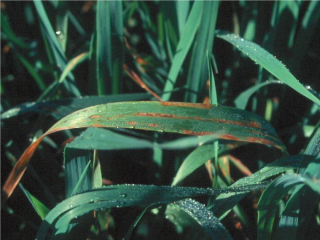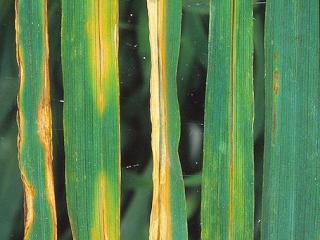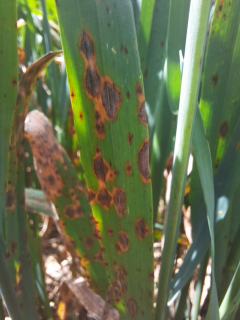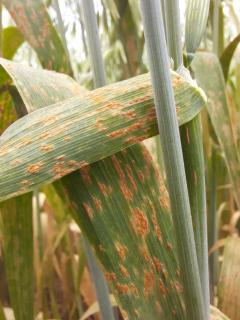Bacterial blight, Septoria avenae blotch and leaf rust are appearing in oats
Bacterial blight
- Muresk
- Yerecoin
- York
- Toodyay
Plant pathologist Kylie Chambers (DPIRD) has reported finding low levels of bacterial blight on oats across the central grainbelt.
There are two types of bacterial blight that affect oats in Western Australia: stripe blight (Pseudomonas syringae pv. striafaciens) and halo blight (Pseudomonas syringae pv. coronafaciens).
Stripe blight is the more common form of the disease in WA. It forms long, red-brown stripes on leaves during winter, which can join into blotches and cause leaf collapse.
Halo blight causes pale green or yellow coloured, oval-shaped spots surrounded by a pale halo with a water-soaked appearance. As the disease develops, these spots turn brown and join together to form blotches.
Both bacterial blights need cool, moist conditions, to infect plants and spread. Normally the infection will stop spreading as canopies dry, and crops are able to outgrow the infection in spring. The recent extended period of mild and wet conditions has been very favourable for expression and spread of bacterial blight.
It is important not to confuse bacterial blight with fungal diseases like Septoria avenae or oat rusts, as fungicides are not effective against bacterial blight. Currently there are no crop protection chemicals suitable (or registered) to control this disease.
For more information, see DPIRD’s Diagnosing stripe blight in oats and Diagnosing halo blight in oats pages.
Septoria avenae blotch and leaf rust
- Gnowellen
- Wellstead
An Agworld user has reported finding Septoria avenae blotch and leaf rust, in oats near Gnowellen and Wellstead.
Septoria avenae blotch is the most prevalent oat disease in Western Australia. Under high disease pressure, it can impact both hay and grain yield and quality. Septoria symptoms can appear as brown to purple oval shaped spots on leaves. These lesions then develop into larger brown blotches up to 2cm in size, which can coalesce to cover most of the leaf. Severe infections can lead to plant lodging. Florets and glumes of plants can also develop blotches, which can cause black staining of seed in some varieties.
The main source of infection is infected crop residue from previous seasons. The sexual stage of the fungus occurs on infected stubble following rainfall, whereby the fungus produces ascospores which are spread moderate distances by wind. The ascospores and are the source of infection in new crops. Secondary spread occurs when the asexual spores formed in the lesions are spread through the crop canopy by rain splash.
In high disease pressure scenarios, such as continuous oat crops, growing ‘susceptible’ or ‘very susceptible’ varieties, and in favourable environments (such as higher rainfall regions) where disease develops into the upper canopy, yield and grain quality losses can occur. In these circumstances, foliar fungicides can reduce disease severity and reduce potential losses to disease.
For a list of registered fungicides to use as foliar sprays for managing Septoria in oats, visit DPIRD’s Registered foliar fungicides for cereals in Western Australia page.
For more information on Septoria avenae blotch, refer to DPIRD’s Diagnosing Septoria avenae blotch in oats and the DPIRD and AgriFutures Septoria avenae blotch disease management guide.
Oat leaf rust (also known as crown rust) can impact both hay and grain yield and quality. The disease is caused by the fungus Puccinia coronata var. avenae. The characteristic symptom is the development of round to oblong pustules which contain yellow-orange coloured spores. The pustules are primarily found on leaves but can also on appear on leaf sheathes and heads. The pustules eventually turn black with age. Leaf rust requires mild temperatures and moist conditions to infect and cause disease.
Leaf rust can be managed through variety choice, fungicide application, managing green bridge and monitoring crops to optimise the response to any disease outbreak. When using fungicides to control rust, it is essential to apply them early in the disease epidemic before severe infection occurs, especially when growing susceptible varieties. The response to fungicide application will be determined by the level of disease present and favourability of seasonal weather conditions.
For a list of registered fungicides to use as foliar sprays for managing oat leaf rust, visit DPIRD’s Registered foliar fungicides for cereals in Western Australia page.
For more information on oat leaf (crown) rust, visit DPIRD’s Oats: leaf diseases page and the DPIRD and AgriFutures Oat stem and leaf (crown) rust management guide.
Further information
To check your oat crops variety susceptibility ratings to these diseases, refer to DPIRD’s 2023 WA Crop Sowing Guide - Oats.
To check out what diseases are impacting oat production, refer to DPIRD’s Plant diseases impacting oaten hay production in Australia – a review.
For more information, refer to DPIRD’s:
- Oats: leaf diseases page
- 2022 Oat disease webinar – Red leather leaf and crown rust video
- 2022 Protecting WA Crops The impact of Septoria avenae blotch and leaf rust on the yield and quality of oaten hay article.
For more information on oat foliar diseases, contact Plant pathologists Kylie Chambers in Northam on +61 (0)8 9690 2151, or Geoff Thomas in South Perth on +61 (0)8 9368 3262.
Article author: Kylie Chambers (DPIRD Northam) and Cindy Webster (DPIRD Narrogin).




